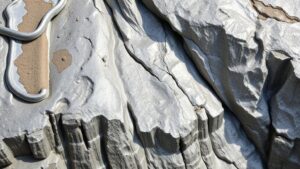Spotting Gold Deposits in Eroded Hillsides Near Rivers
Spotting Gold Deposits in Eroded Hillsides Near Rivers
The search for gold has captivated humanity for centuries, leading to countless discoveries and the establishment of entire economies. One of the most effective methods of locating gold deposits involves understanding the geological and hydrological contexts in which gold is typically found. This article explores the techniques for spotting gold deposits in eroded hillsides near rivers, a promising area for prospectors due to significant geological processes.
Geological Context of Gold Deposits
Gold is often found in areas with specific geological settings. It typically forms in quartz veins or alluvial deposits. In eroded hillsides near rivers, gold is generally a remnant from ancient river systems where it was deposited millions of years ago. Understanding the stages of erosion and sediment transport is crucial for identifying where gold might be located.
Hydrological Influence on Gold Distribution
Rivers play a significant role in the transportation of gold particles. As water flows through the landscape, it erodes rocks and soils, carrying with it sediment that may contain gold. The key processes include:
- Weathering: Physical and chemical weathering breaks down rocks, releasing gold particles.
- Erosion: Running water erodes the landscape, transporting gold downstream where it can settle in quieter sections of the river.
- Deposition: Gold particles tend to settle in areas of reduced flow velocity, such as behind boulders or in natural depressions.
Identifying Eroded Hillsides
When looking for gold deposits in eroded hillsides, consider the following geological features:
- Cliffs and Steep Slopes: These areas often reveal bedrock and historical deposits that may reveal gold sources.
- Terraces: River terraces can indicate previous river levels and might contain significant alluvial deposits.
- Stream Beds: Examination of dry or seasonal stream beds can introduce promising areas where sediments have settled.
Techniques for Prospecting
Various techniques can be employed to locate gold deposits in these landscapes:
- Panning: This traditional method involves using a pan to wash sediment and separate gold from lighter materials. It can provide substantial initial insight into whether an area is promising.
- Sluicing: In contrast to panning, sluicing involves running water through a sluice box that captures heavier materials like gold while allowing lighter materials to wash away.
- Geophysical Methods: Techniques such as ground penetrating radar (GPR) and resistivity surveys can help identify potential gold-rich areas beneath the surface without extensive manual excavations.
Case Studies: Successful Gold Discovery
Several notable discoveries have illustrated the effectiveness of prospecting in eroded hillsides near rivers. For example, the California Gold Rush in the mid-19th century was partly driven by discoveries in riverbeds and eroded terranes. In more recent times, in the Klondike region of Canada, many prospectors achieved success by focusing on gravels left by ancient river systems.
Challenges and Considerations
While prospecting for gold can be rewarding, challenges do exist:
- Environmental Regulations: Many regions are subject to strict environmental laws that regulate prospecting and mining activities.
- Safety Concerns: Eroded hillsides can be unstable, and working near water presents additional hazards, including drowning risk.
- Competition: Popular areas for gold mining often attract other prospectors, necessitating patience and strategy in exploring less popular zones.
Actionable Takeaways
For those interested in prospecting for gold in eroded riverbanks, the following steps can enhance the likelihood of successful discoveries:
- Conduct thorough geological research to identify promising areas based on historical mining records.
- Use a combination of traditional methods (like panning) and modern technology (like GPR) for a comprehensive exploration strategy.
- Always adhere to local laws and regulations to ensure sustainable and responsible prospecting practices.
By understanding the natural processes that contribute to gold deposition and employing effective prospecting techniques, aspiring gold seekers can significantly increase their chances of uncovering hidden treasure along eroded hillsides near rivers.


